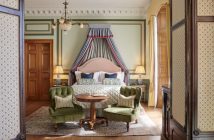The plane is old, very old; without doubt the oldest plane I’ve ever been in and the stewards look ugly and dangerous. We are heading from Rome to Naples – the wild, filthy soul of the South and there is a sense that just about anything could happen. There are ashtrays in the arms of our chairs – that’s how old this plane is. It’s a shock when we eventually take off; it happens suddenly and there’s a steep ascent, but it’s only a very short flight, as soon as we are in the air we begin our juddering descent.
Naples and the Amalfi coast – they’re neighbours, but the fence between them is as high as one could possibly imagine – I can think of no other adjoining areas that are so at odds with one another conceptually. Every year thousands of visitors come to this area of Italy. Busloads and busloads of pink, wobbly tourists, weighed down by expensive cameras and bulging fanny packs, arrive and neatly side-step the ancient, fascinating city of Napoli. They scoot off to the port and escape on the ferry, in favour of the pastel pinks of Positano with its promise of mosaic alleyways and warm nights of Limoncello-fuelled oblivion. We feel a need to head into town before catching the boat to Capri – a glimpse of hell before sailing off into the sunset.
Piazza Garibaldi is busy as we jump off the bus. Hot, sticky air mixes with the scent of scorched tarmac and something decidedly bodily. There is rubbish everywhere – I’ve never been anywhere messier. Domestic waste, furniture and clothing spews all over the sweating streets, mixing with cigarette butts and the swollen fruit that lines the gutters. This is a truly remarkable place to find yourself in: it’s intoxicating, the buildings around are crumbling, but there’s a dark, haunting beauty to it all; it taunts you with a sense of sweet, sultry danger. We make our way down towards the port, through markets filled with the smell of Russian cigarettes and drying fish guts – it’s a dream of a place or a nightmare, depending on how far the romantic in you stretches.
Just one hour later and our ferry pulls into Capri port, I’m wearing pale linen and carrying an E.M. Forster novel and all that dirty, frenetic energy seems far, far away. We ask the taxi driver for “Capri Palace, Anacapri” and we’re off, our open-topped taxi winding its way up the mountainside, the lights of the Campanian coastline twinkling in the distance. Here it’s intoxicating again: strong scents fill our noses, but now its jasmine and honeysuckle, ripe and sweet – it’s like the island is cleansing us, sorting us out after our corrupting interlude in Sin City.
The Capri Palace is unlike any hotel I have ever stayed in. It stands tall and multilayered rearing up over the hilltop village of Anacapri and is, without doubt, the island’s most elegant address. The hotel was opened in August 1960, a time when Aristotle Onassis used sail around the island in vulpine, predatory circles, staying at The Capri Palace and dropping in to its beach club, ‘Il Riccio’. Il Riccio is truly sublime: a beach bar on a rock that stares out into endless aquamarine. There’s a simple, timeless quality – you experience the incomparable delight of eating sea urchin spaghetti in a cliff top restaurant as the afternoon sun shines down.
The Capri palace is best known for three things: an extraordinary collection of post-war Italian art, a world class medical spa and L’Olivo – the island’s best restaurant. L’Olivo is the kind of place Onassis would have adored; eating there is an unrepentantly luxurious and emotionally engaging experience. The chairs are draped in thick Loro Piana cashmere, there is a reassuringly ‘pre-crunch’ water list, and later in the evening I’m offered a cheese which has ‘been hidden for a year, underground, by a tree where truffles grow’. The restaurant serves Ornellaia olive oil with your bread; it’s a place that makes you feel like a king.
The rooms are also a point of pride. After our late arrival, I’m delighted to find we’ve been upgraded to a deluxe room with a hillside garden view. Each of the 78 rooms and suites seem to be inspired by fine art or feminine beauty. There is the Monroe or the Callas if you’re looking to feel at one with starlets of old, or the Paltrow if you want something more contemporary. The Magritte comes complete with a hand-painted surrealist work on the floor of its private pool – this is a rare kind of detail.
I feel I must also mention the spa. I never planned to enroll in a leg school – Sarah perhaps, but not me. The leg treatment school here has a global following; it’s been running for decades. Spa director, Professor Canonaco, spent nine years working on this mystical process, a process that has been oversubscribed for the last twenty years. When we’re both offered a taste, I really can’t refuse – if it’s good enough for Gwyneth, Liz Hurley and Helena Christensen, it must be worth a chance. But my God, I now know these women suffer for their beauty. It is a painful, humbling experience, involving thick medicated mud, frozen bandages, the intense discomfort of walking slowly through ice cold water and harsh words of derision from stern, raven-haired young women. The results on me are rather horrifying, red blotchy legs that shiver and spasm, but Sarah’s look fantastic – she’s been considerably more stoic throughout the whole process, no moaning, no extra blankets – it looks like the gods have rewarded her kindly. I have no doubt she’ll look radiant for weeks – they claim the process improves circulation and draws toxins from the darkest corners of your soul.
So what to take from my trip to Capri via Naples? There is a sense that the old adage ‘see Naples and die’ rings true: it is a place with a rare beauty, but it’s been plundered, pushed to the edge of its capabilities by brutal industry and human profligacy. In addition to this, there is an all-too-real sense that the city may indeed take your life. And Capri? Well, Capri and The Capri Palace remind me that real luxury still exists; precise luxuries that reveal themselves in manifold ways. It also taught me that great legs come at a high price – one that I’m afraid I’m not willing to pay.




